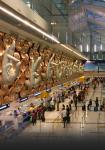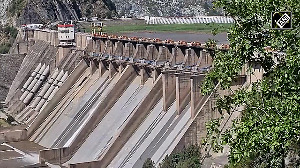With the committee of experts of the SAARC Countries having resolved all the contentious issues during their meeting in Kathmandu from November 29 to December 1, the South Asia Free Trade Agreement is all set to come into force on January 1, 2006.
Although the 13th South Asian Association for Regional Cooperation summit in Dhaka had reiterated its commitment to SAFTA, the prospects of agreement scheduled to come into force on January 1, 2006, seemed remote.
Moreover, the expansion of SAARC, with Afghanistan's admission as the eighth member and China and Japan being accorded observer status, was expected to deflect attention and create roadblocks in the path for creating a proper roadmap for SAFTA.
The Dhaka summit had left a number of key issues unresolved: these included finalisation of revenue compensation mechanism, promulgation of sensitive lists, and negotiations on rules of origin, and it seemed that politics will once again stall the most significant economic stride being attempted by the region.
It is indeed sad commentary on regional economic cooperation that intra-regional trade is still languishing below 5 per cent of the global trade of the member states.
Removal of trade barriers and all other irritants hampering free trade in the SAARC region would result in a win-win situation for all. South Asian states have taken long to overcome their mutual suspicion and to relate to one another as a bloc.
Even after the creation of SAARC it took ten years to create SAARC Preferential Trading Arrangement (SAPTA), which came into force in December 1995. In January 1996, SAARC commerce ministers reiterated their commitment to accelerate the SAPTA process and set realisation of SAFTA as the goal.
A report titled SAARC: Vision Beyond the Year 2000 was submitted to the Tenth SAARC Summit in Colombo in 1998. The report envisaged a Free Trade Area by the year 2010, a Customs Union by 2015 and an Economic Union by 2020.
However, the entire process came to a grinding halt mainly because of the rapid deterioration in Indo-Pak relations. It took four years to put the process back on the rails and finally it was the last summit at Islamabad, where the Framework Agreement for a South Asia Free Trade Area was signed.
The agreement as it stands today requires all countries to reduce tariffs to 5 per cent and below. The time schedule for reduction of tariffs is as follows:
(a) The non-least developed countries namely India, Pakistan and Sri Lanka are to reduce the existing tariff rates to 30 per cent by January 1, 2008.
(b) Least developed countries (LDC), namely Bangladesh, Nepal, Bhutan and Maldives are to reduce the existing tariff rates to 30 per cent. Significantly the agreement classifies Maldives as an LDC even though it has not been designated as one by the United Nations.
(c) India and Pakistan are required to reduce tariffs to 5 per cent or below by Jan 1, 2013 and Sri Lanka by Jan 1, 2014.
(d) LDCs are to reduce tariffs to 5 per cent or below by Jan 1, 2016.
(e) Notwithstanding the above timeframe the Non-Least Developed countries shall reduce their tariff to 5 per cent for the products of LDCs within a timeframe of three years beginning from the date of coming into force of the agreement.
The agreement envisages that the reduction in tariffs should as far as possible be in equal annual instalments. It has a provision for sensitive lists and the tariff reduction will not be applicable to the items in these lists. There will be different sensitive lists applicable to LDCs and other states.
These sensitive lists will be reviewed regularly at intervals not exceeding four years with the purpose of curtailing them. It recognises that the LDCs will lose customs revenue due to the implementation of the Trade Liberalisation Programme (TLP) and has recommended establishment of a mechanism to compensate them for the loss.
This mechanism and its rules and regulations are required to be established prior to the commencement of the TLP. The fact that this mechanism had not been finalised during the Dhaka Summit and the sensitive lists had not been promulgated, had given credence to the speculation that SAFTA may not come in time.
However, the committee of experts has amicably settled all the issues including sensitive lists, compensation to LDCs against revenue losses and rules of origin.
The meeting has agreed to compensate the LDCs, for four years for the loss of revenue on account of lowering of the customs duty.
The sensitive lists have been promulgated. India's sensitive list includes 850 items whilst that of Bangladesh includes 1050 items.
Pakistan has managed to get approved for a sensitive list of 1,180 items that is the 22.5 per cent of the total tariff lines and is more than the 20 per cent ceiling stipulated in the agreement. As regards the rules of origin, it was decided in the meeting that 30 per cent value addition plus change in tariff heading (CTH) is allowed to LDCs and 40 per cent value addition plus CTH to other countries.
SAFTA would create the world's biggest free trade area and lead to poverty alleviation in a region that is home to 1.4 billion people, including 60 per cent of the world's poor. There is no doubt that SAFTA is in the interest of the region but the political environment in the region makes any forecast of its outcome extremely hazardous. One of the shortcomings of the SAFTA is that it does not incorporate the services -- a major component of the regional economy. This is a major drawback, as services have become major drivers of the economy in the region and account for over 50 per cent of the GDP in most of the
countries.
It is also silent on liberalisation of investment in the region. The movement of capital can compensate the trade imbalance of LDCs and is therefore necessary for stimulating trade. The foreign ministers' meeting prior to SAARC summit in Dhaka had recommended setting up of a high economic council to push regional integration forward to include 'trade in services, enhanced investment and harmonising of customs union and, beyond that, a South Asian Economic Union.'
There is no doubt that if SAFTA is to succeed the infrastructure of the region must be integrated to facilitate interlinking of trade. Cooperation in the field of energy and strengthening of transportation, transit and communication links in the region are essential for fostering meaningful economic cooperation and to achieve the ultimate objective of a South Asian Economic Union.
If successful, SAFTA will not only prove to be a panacea for the economic ills plaguing the region but will also foster close people to people contact. It will also create dependencies amongst the nations that will go a long way to bridge the contentious political divide that has prevented the region from pursuing its optimal economic potential.
The author is a New Delhi-based strategic analyst.







 © 2025
© 2025